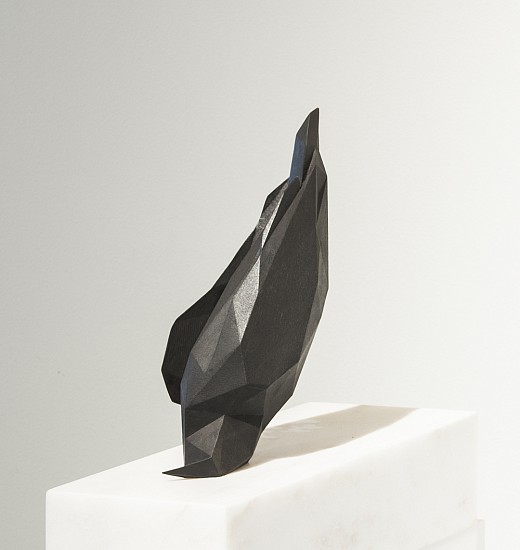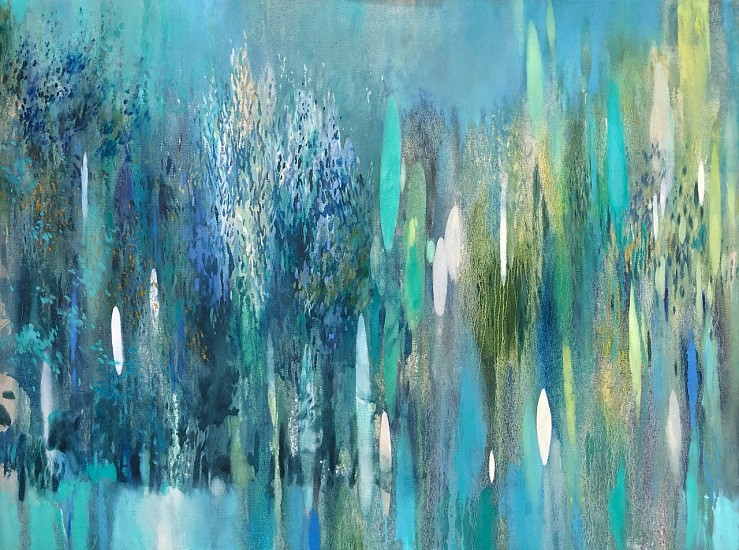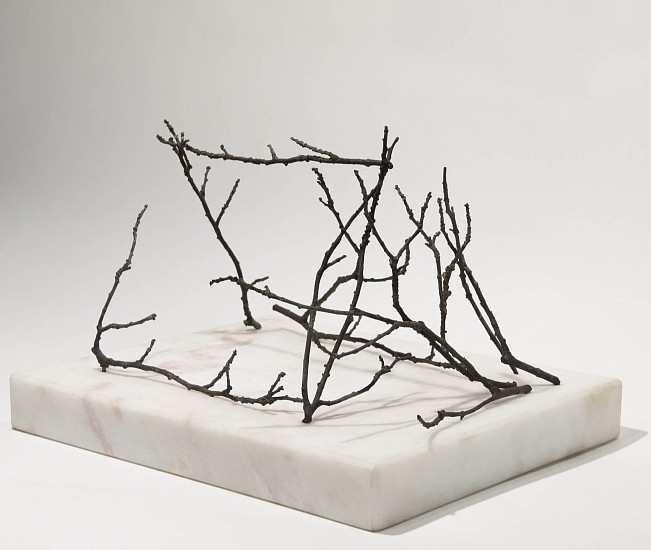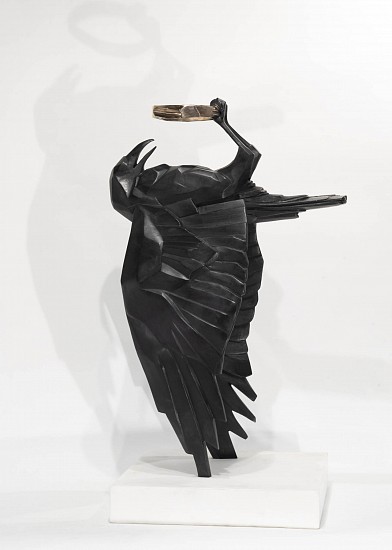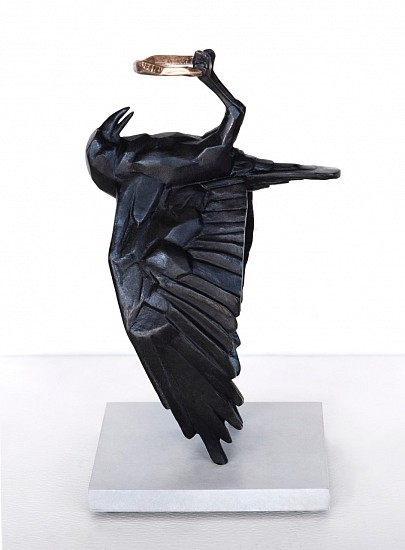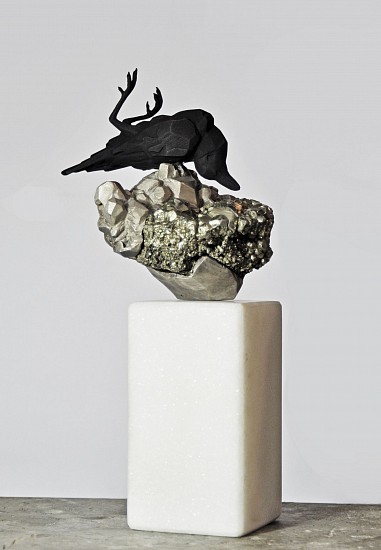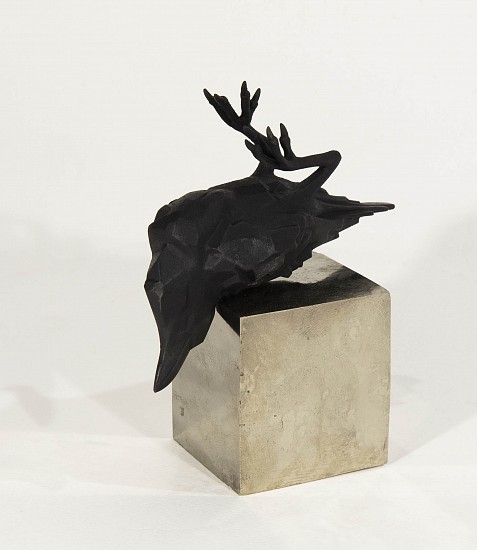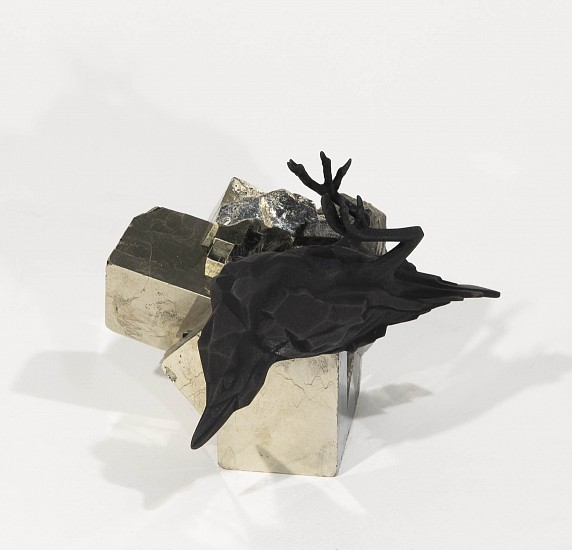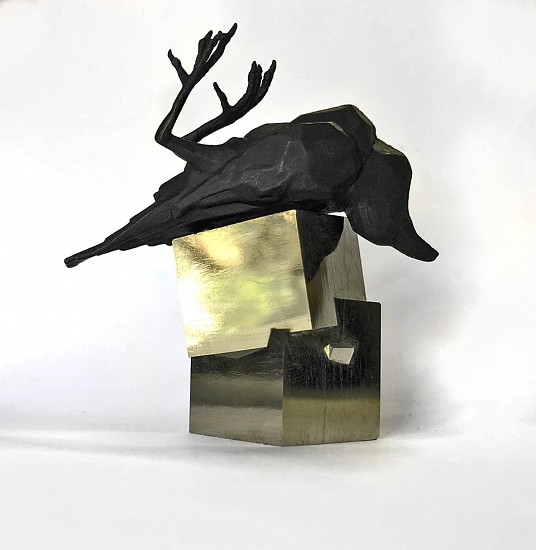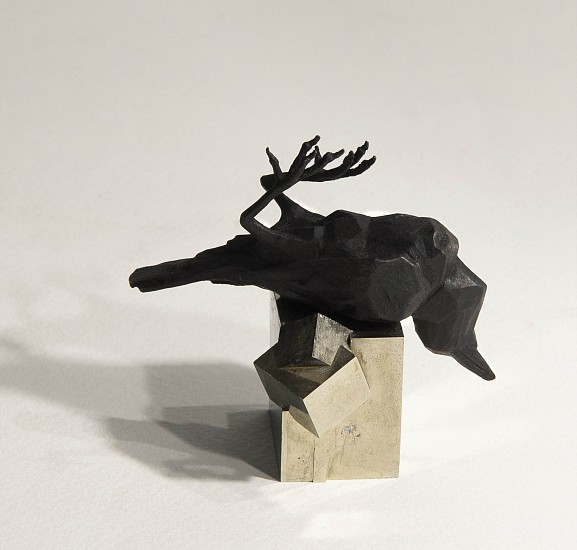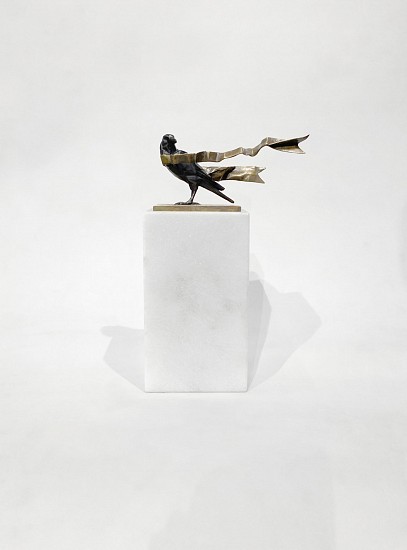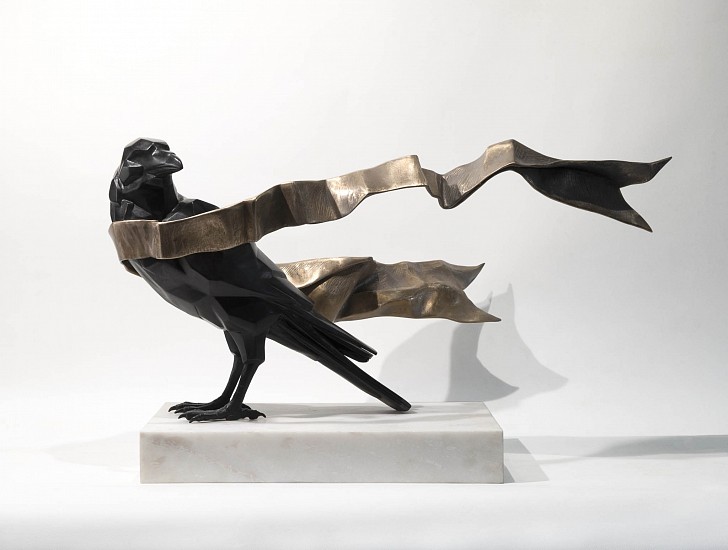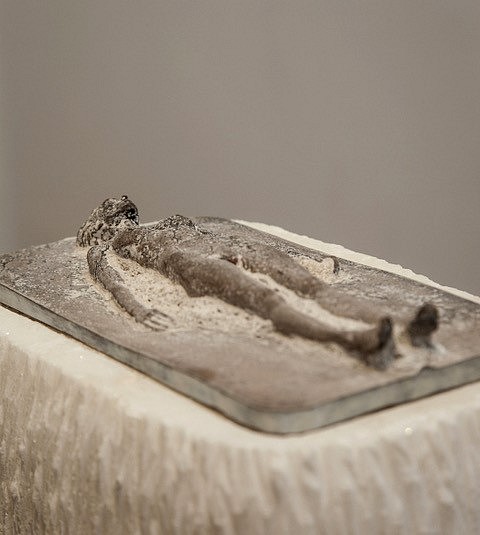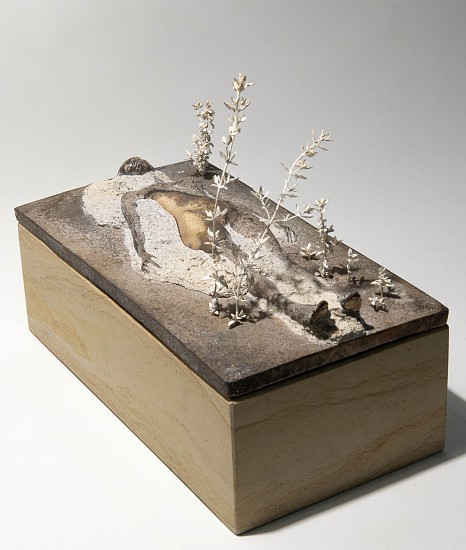RINA STUTZER
Rina Stutzer’s work is elusive; in a constant process of becoming, the pieces evolving out of each other, often guided by intuitive impulses. She is drawn to making works that are not fixed; whose identity is ambiguous (as with the crow) and transitory, provisional (as with the nomad). All we know of the world is that we are passing through it and the the works in this exhibition poignantly telegraph the impermanence of all things.
“Stutzer uses crows in her work as a metaphor for human beings and their place in the world. We are reminded of Ted Hughes’s crow poems – where the corvid is infinitely adaptable, unpredictable, inexhaustible, and capable of mischief. Here the crow also stands for the artist herself: both operate outside of society, both are subversive, and both are tricksters playing with the possibilities of reality.
The tent is a recurring image in her work and here Stutzer’s structure is made of delicate and ephemeral twigs - a temporary dwelling, not unlike our own skins, that we inhabit during our journey through the world. “The tent is explicitly yonic in many of Stutzer’s works; we are reminded of the emergence of humanity into the world, the birth of a child – the human spirit moving from womb to world, belonging in neither, only ever visiting both.” - Miranthe Staden Garbett
Stutzer’s female form in “corpse pose” is between life and death, in a state of transition between different realms, impossible to pin down.
Contact: info@everardlondon.com
Image credit: Carla Crafford / Dan Weill Photography
Rina Stutzer’s work is elusive; in a constant process of becoming, the pieces evolving out of each other, often guided by intuitive impulses. She is drawn to making works that are not fixed; whose identity is ambiguous (as with the crow) and transitory, provisional (as with the nomad). All we know of the world is that we are passing through it and the the works in this exhibition poignantly telegraph the impermanence of all things.
“Stutzer uses crows in her work as a metaphor for human beings and their place in the world. We are reminded of Ted Hughes’s crow poems – where the corvid is infinitely adaptable, unpredictable, inexhaustible, and capable of mischief. Here the crow also stands for the artist herself: both operate outside of society, both are subversive, and both are tricksters playing with the possibilities of reality.
The tent is a recurring image in her work and here Stutzer’s structure is made of delicate and ephemeral twigs - a temporary dwelling, not unlike our own skins, that we inhabit during our journey through the world. “The tent is explicitly yonic in many of Stutzer’s works; we are reminded of the emergence of humanity into the world, the birth of a child – the human spirit moving from womb to world, belonging in neither, only ever visiting both.” - Miranthe Staden Garbett
Stutzer’s female form in “corpse pose” is between life and death, in a state of transition between different realms, impossible to pin down.
Contact: info@everardlondon.com
Image credit: Carla Crafford / Dan Weill Photography
Rina Stutzer’s work is elusive; in a constant process of becoming, the pieces evolving out of each other, often guided by intuitive impulses. She is drawn to making works that are not fixed; whose identity is ambiguous (as with the crow) and transitory, provisional (as with the nomad). All we know of the world is that we are passing through it and the the works in this exhibition poignantly telegraph the impermanence of all things.
“Stutzer uses crows in her work as a metaphor for human beings and their place in the world. We are reminded of Ted Hughes’s crow poems – where the corvid is infinitely adaptable, unpredictable, inexhaustible, and capable of mischief. Here the crow also stands for the artist herself: both operate outside of society, both are subversive, and both are tricksters playing with the possibilities of reality.
The tent is a recurring image in her work and here Stutzer’s structure is made of delicate and ephemeral twigs - a temporary dwelling, not unlike our own skins, that we inhabit during our journey through the world. “The tent is explicitly yonic in many of Stutzer’s works; we are reminded of the emergence of humanity into the world, the birth of a child – the human spirit moving from womb to world, belonging in neither, only ever visiting both.” - Miranthe Staden Garbett
Stutzer’s female form in “corpse pose” is between life and death, in a state of transition between different realms, impossible to pin down.
Contact: info@everardlondon.com
Image credit: Carla Crafford / Dan Weill Photography
Rina Stutzer’s work is elusive; in a constant process of becoming, the pieces evolving out of each other, often guided by intuitive impulses. She is drawn to making works that are not fixed; whose identity is ambiguous (as with the crow) and transitory, provisional (as with the nomad). All we know of the world is that we are passing through it and the the works in this exhibition poignantly telegraph the impermanence of all things.
“Stutzer uses crows in her work as a metaphor for human beings and their place in the world. We are reminded of Ted Hughes’s crow poems – where the corvid is infinitely adaptable, unpredictable, inexhaustible, and capable of mischief. Here the crow also stands for the artist herself: both operate outside of society, both are subversive, and both are tricksters playing with the possibilities of reality.
The tent is a recurring image in her work and here Stutzer’s structure is made of delicate and ephemeral twigs - a temporary dwelling, not unlike our own skins, that we inhabit during our journey through the world. “The tent is explicitly yonic in many of Stutzer’s works; we are reminded of the emergence of humanity into the world, the birth of a child – the human spirit moving from womb to world, belonging in neither, only ever visiting both.” - Miranthe Staden Garbett
Stutzer’s female form in “corpse pose” is between life and death, in a state of transition between different realms, impossible to pin down.
Contact: info@everardlondon.com
Image credit: Carla Crafford / Dan Weill Photography
Rina Stutzer’s work is elusive; in a constant process of becoming, the pieces evolving out of each other, often guided by intuitive impulses. She is drawn to making works that are not fixed; whose identity is ambiguous (as with the crow) and transitory, provisional (as with the nomad). All we know of the world is that we are passing through it and the the works in this exhibition poignantly telegraph the impermanence of all things.
“Stutzer uses crows in her work as a metaphor for human beings and their place in the world. We are reminded of Ted Hughes’s crow poems – where the corvid is infinitely adaptable, unpredictable, inexhaustible, and capable of mischief. Here the crow also stands for the artist herself: both operate outside of society, both are subversive, and both are tricksters playing with the possibilities of reality.
The tent is a recurring image in her work and here Stutzer’s structure is made of delicate and ephemeral twigs - a temporary dwelling, not unlike our own skins, that we inhabit during our journey through the world. “The tent is explicitly yonic in many of Stutzer’s works; we are reminded of the emergence of humanity into the world, the birth of a child – the human spirit moving from womb to world, belonging in neither, only ever visiting both.” - Miranthe Staden Garbett
Stutzer’s female form in “corpse pose” is between life and death, in a state of transition between different realms, impossible to pin down.
Contact: info@everardlondon.com
Image credit: Carla Crafford / Dan Weill Photography
Rina Stutzer’s work is elusive; in a constant process of becoming, the pieces evolving out of each other, often guided by intuitive impulses. She is drawn to making works that are not fixed; whose identity is ambiguous (as with the crow) and transitory, provisional (as with the nomad). All we know of the world is that we are passing through it and the the works in this exhibition poignantly telegraph the impermanence of all things.
“Stutzer uses crows in her work as a metaphor for human beings and their place in the world. We are reminded of Ted Hughes’s crow poems – where the corvid is infinitely adaptable, unpredictable, inexhaustible, and capable of mischief. Here the crow also stands for the artist herself: both operate outside of society, both are subversive, and both are tricksters playing with the possibilities of reality.
The tent is a recurring image in her work and here Stutzer’s structure is made of delicate and ephemeral twigs - a temporary dwelling, not unlike our own skins, that we inhabit during our journey through the world. “The tent is explicitly yonic in many of Stutzer’s works; we are reminded of the emergence of humanity into the world, the birth of a child – the human spirit moving from womb to world, belonging in neither, only ever visiting both.” - Miranthe Staden Garbett
Stutzer’s female form in “corpse pose” is between life and death, in a state of transition between different realms, impossible to pin down.
Contact: info@everardlondon.com
Image credit: Carla Crafford / Dan Weill Photography















